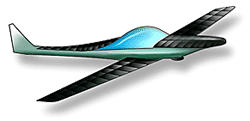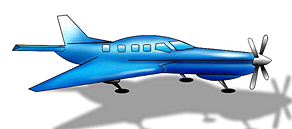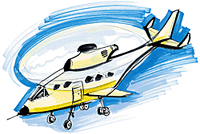|
|
|
SOLAR-POWERED
GLIDER
With
its solar panels integrated with all the hydrofoil surfaces and battery
pads, there is no more need to worry about having to land in the
country, especially in stony areas or vineyards. At the press of a
button the electric engine with wide-diameter folding blades can be
turned on. This will enable you to regain height or to find a more
suitable and safer landing area.
|

|
|
It is possible to take-off autonomously and without tugging, you will
also economise in this regard and remain independent. Its finesse is
higher than 40, its rate of fall lower than 0,78m/s and its VNE of
300km/h meets the characteristics of a high-performance glider.
|
|
|

|
PRIVATE
AERODYNAMIC PLANE
Amongst
all
the different models of 4-seater planes sold in the world, very few give
a high performance at a reasonable price per hour's flying. In fact,
to reach this goal the restrictions are extreme and only a design
optimised at every level can
achieve this. Whether at an aerodynamics level, use of materials,
cooling or propulsion system etc., nothing must be neglected. We have
worked as a team to this end and we are now in a position to present to
you our project for a plane which we have christened ãBR.5ä.
|
|
Our aim is to enable a dynamic business to
develop a series of crafts in declined compounds under different
motorizations, thereby placing it in a dominating position in
the world market. In light of the results of our research on the
quality and performance of different models of planes on sale at the
moment, it seemed perfectly realistic and profitable to envisage, in the
short term, the development of a flying school and of flights with
optimised aerodynamics which meet criteria for economy and performance.
It would target schools, clubs, businesses and individuals.
|
|
In completing the plans for this private plane, our ambition was
to integrate top innovative systems and techniques enabling it to
surpass all of its competitors in terms of performance, safety,
consumption, comfort and noise pollution. We have chosen to give
priority to the following points which will give the well-informed a
good understanding of this plane's qualities.
|
|
1
Qptimised aerodynamics, due to
-
-
an engine with a very small frontal area
-
- an engine with a liquid cooling system
-
- a small main frame fuselage
-
- the adoption of a bio-convex profile with a laminar pocket
-
- retractable tricycle landing gear
-
- a small wet area
-
-
a small drag factor
2.
Maximum safety and piloting pleasure, due to
-
-
an advanced soundproofing of the engine and emissions integrated into the
engine's design
-
- a gust absorber system
-
- winged air brakes to control the approaching descent without changing
the induction pressure
Necessary for a shim plane, the air brake guarantees safety in the event
of an engine failure when
landing
in the country
-
- a very low
breaking-off speed possible because of the combination of various lifting
devices
3.
A low running cost, due to :
-
-
low consumption engine- from 195gr/cv/h to 158gr/cv/h
-
- an exceptionally
enduring engine composed of a small number of moving components (50%
less
than in a conventional engine)
-
-
minimum maintenance of the airframe, possible through the use of
compound materials
-
- high airframe potential
(at least 20 000h)
-
- an engine which carries
no risk of thermal shock
4.
Multifunctional, maximum profitability:
5.
Advanced
ergonomics including
6.
Exceptional performance, due to
-
- a propeller of a wide
diameter- 81% output
-
- a low-speed engine (and
therefore propeller) rotation
-
- electronic control of
the propeller pad for constant running at maximum output
-
- low fuel consumption
-
- a wide use of pre-impregnated compound materials giving a
small mass when empty
-
- a small smt.cfe
-
- aerobatics capacity
(+6g, -5g)
|
|
Other
parameters which are also important, but which we will not go into great
detail on here, were integrated into the schedule of conditions to
homogenise the BR.5. Because
of the great technological progress in recent decades, it seems all the
more justifiable today to imagine the investment necessary for the
certification of a modem aircraft such as this, which integrates the
latest technical innovations.
The
BR.5 reaches, with only 200 cv, a cruising speed of l93Kts (at 75% of its power ie. 150 cv) and a maximum speed of2l 1 Kts at FL
50.
The construction of two other models is in progress with the view to
creating a complete range:
*an aircraft identical to the latter, but turbo compressed, with a power
of 300cvs;
*a flying school plane of the same configuration but with a lighter
airframe, motorised by 120cv.
|
|

|
VTOL
600
km per hour for a VTOL is now possible with our innovative technology in
turning sails (this is not illustrated for the obvious reason of
confidentiality). Intended for transporting passengers or merchandise,
this VTOL is a total change of approach to the helicopter as we know it
today. This is neither a craft with a tilt rotor, nor a craft with
advanced vector thrust, but a design with unusually-shaped rotors and
blades which allows vertical or non-vertical takeoffs and landings,
according to the pilot's choice. Take off and landing like a plane or
a helicopter is a reality which new materials allow today.
|
|